The pandemic has been a difficult period for performers of all kinds, from athletes to artists. The Japanese-American performance artist Ei Arakawa was among those who felt the effects. The collaborative, improvisational events for which he is known, such as a giant collective drawing session in the Turbine Hall of the Tate Modern and a performance imagining activities at a “WeWork for babies,” were difficult to pull off with live gatherings suspended and the art world’s frequent flyers grounded.
For encouragement, Arakawa looked to another person used to working in public who was also having trouble coping: the tennis player Naomi Osaka, who has spoken openly about her struggles with mental health. He also found signs of resilience in the outdoor restaurant structures that have proliferated on the streets of New York. Both sources of inspiration figure in the aptly titled “Social Muscle Rehab,” a new exhibition and performance at Artists Space, where Arakawa has constructed and installed a regulation-size dining shed in the basement gallery and is organizing a cathartic outdoor event for October 16 involving a flurry of tennis balls.
He is also marking the publication of his first monograph (Ei Arakawa: Performance People, a joint project of Artists Space and Kunstverein für die Rheinlande und Westfalen, Düsseldorf), which covers nearly two decades of his projects and explores some of his historical influences (which include performance art groups such as Japan’s Gutai and the international Fluxus movement.) A book release party at the gallery, featuring karaoke, is planned for October 10.
Recently, Arakawa spoke to Artful to share some of his inspirations and discuss his new anxieties about socializing and making art in the wake of Covid.
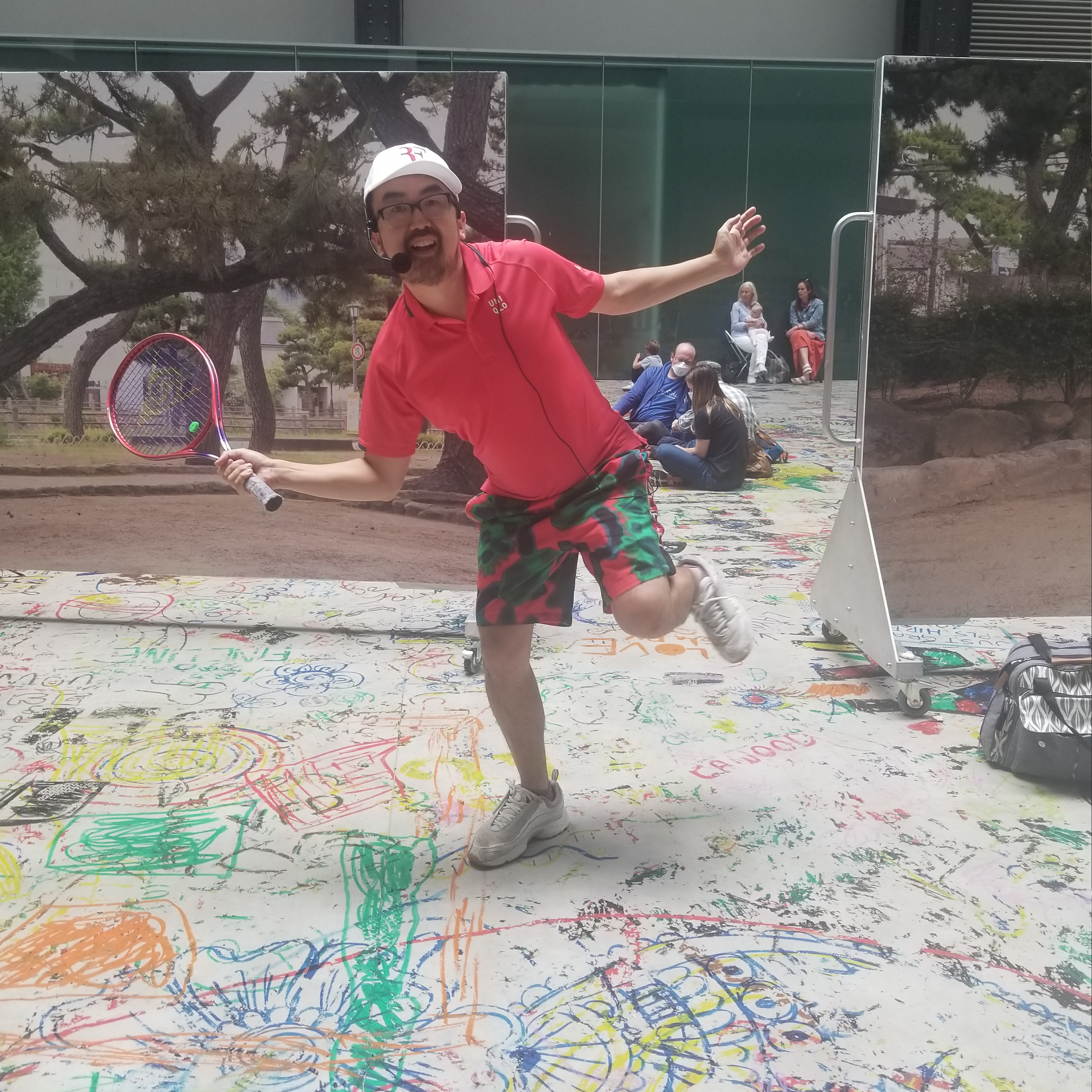 Karen Rosenberg: You are a longtime New Yorker, having lived here for some two decades. What was your experience of the city during the pandemic?
Karen Rosenberg: You are a longtime New Yorker, having lived here for some two decades. What was your experience of the city during the pandemic?
Ei Arakawa: I lived in New York for twenty-one years, from 1998 to 2019, when I relocated to Los Angeles. I think of New York as my home, after Japan, and I have a long history of creating work here. A lot of my performances are immersed in the city. But I was in L.A. during the pandemic time, and from a distance I saw New Yorkers suffering. That’s the background of this project, the reason I put an outdoor dining shed in the show. I wanted to have a better understanding, physically and performatively, of this moment. It’s a conversation with the city, somehow.
KR: When was it that you first saw the outdoor dining structures that inspired your installation at Artists Space?
EA: I don’t recall exactly, but I remember that in August 2020 I came to New York and it was very quiet. Then, that winter, outside structures were suddenly everywhere. It happened very quickly and it was almost the city’s involuntary response, like an immediate reaction to a memory.
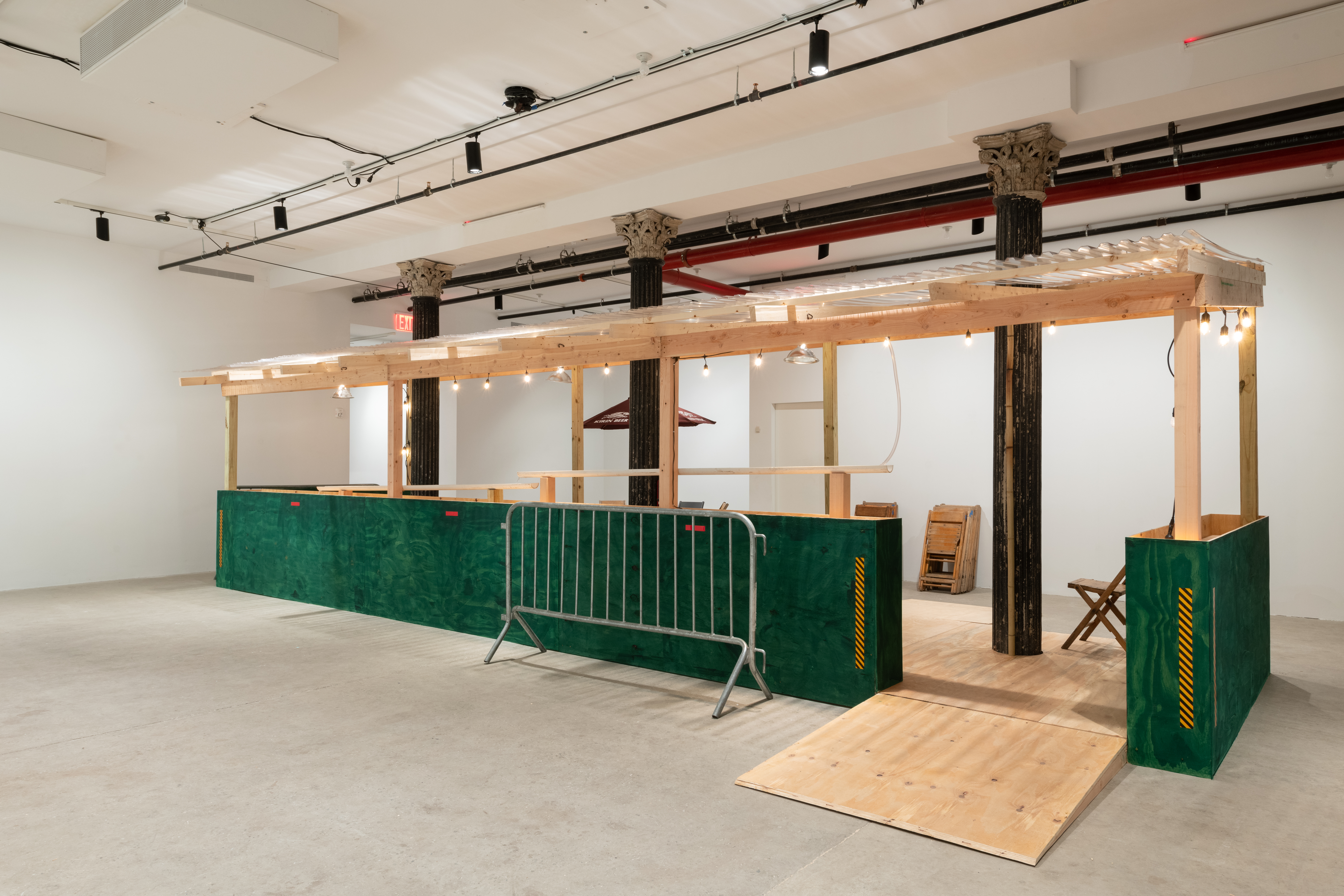 KR: You have said that you were also inspired by seeing a Japanese kotatsu, a type of heated table topped with a blanket or futon, inside an outdoor dining shed in NYC. Can you tell me more about kotatsu and what seeing one in this context meant to you?
KR: You have said that you were also inspired by seeing a Japanese kotatsu, a type of heated table topped with a blanket or futon, inside an outdoor dining shed in NYC. Can you tell me more about kotatsu and what seeing one in this context meant to you?
EA: In Japan every family has a kotatsu table in their living room, and they sit inside this structure. It’s very communal—your feet are touching the feet of other family members. I didn’t expect to see the kotatsu structure on the streets of New York, in wintertime. The kotastu is a very hospitable and cozy device, but it was an extreme environment with the winter wind blowing through the structures. It was so harsh—Covid and cold weather, and then you are trying to be communal.
KR: Yes, it was amazing to see everyone dining outdoors huddled under blankets in their puffer coats, like, “We’re going to keep going to restaurants, even if we have to do this.”
EA: It’s a kind of self-care. We had a moment that winter, and that’s when I started to love this corral structure and see it as sort of an emotional reaction of New Yorkers.
KR: You have also called the outdoor dining structures “collective monuments.” What did you mean by that?
EA: From uptown to the Lower East Side, there’s always this same shape—different decorations, but always this repetition of a small hut. It’s almost like they choreographed it. It is a performance, for me. Also, no one knows how long these structures will last. People say they will stay after Covid, but they are sort of a monument to this damaging, destructive time we are having. I wanted to frame that perspective as art, to have it somehow in quotation marks.
It’s funny because when people come to the show they expect something, but this is almost nothing, even though it’s a big structure. If you live in New York it’s a structure you see every day. So it’s kind of a strange reaction we’ve been having to the show. People say, “What’s so special about it?” Some people sit down, some people just leave.
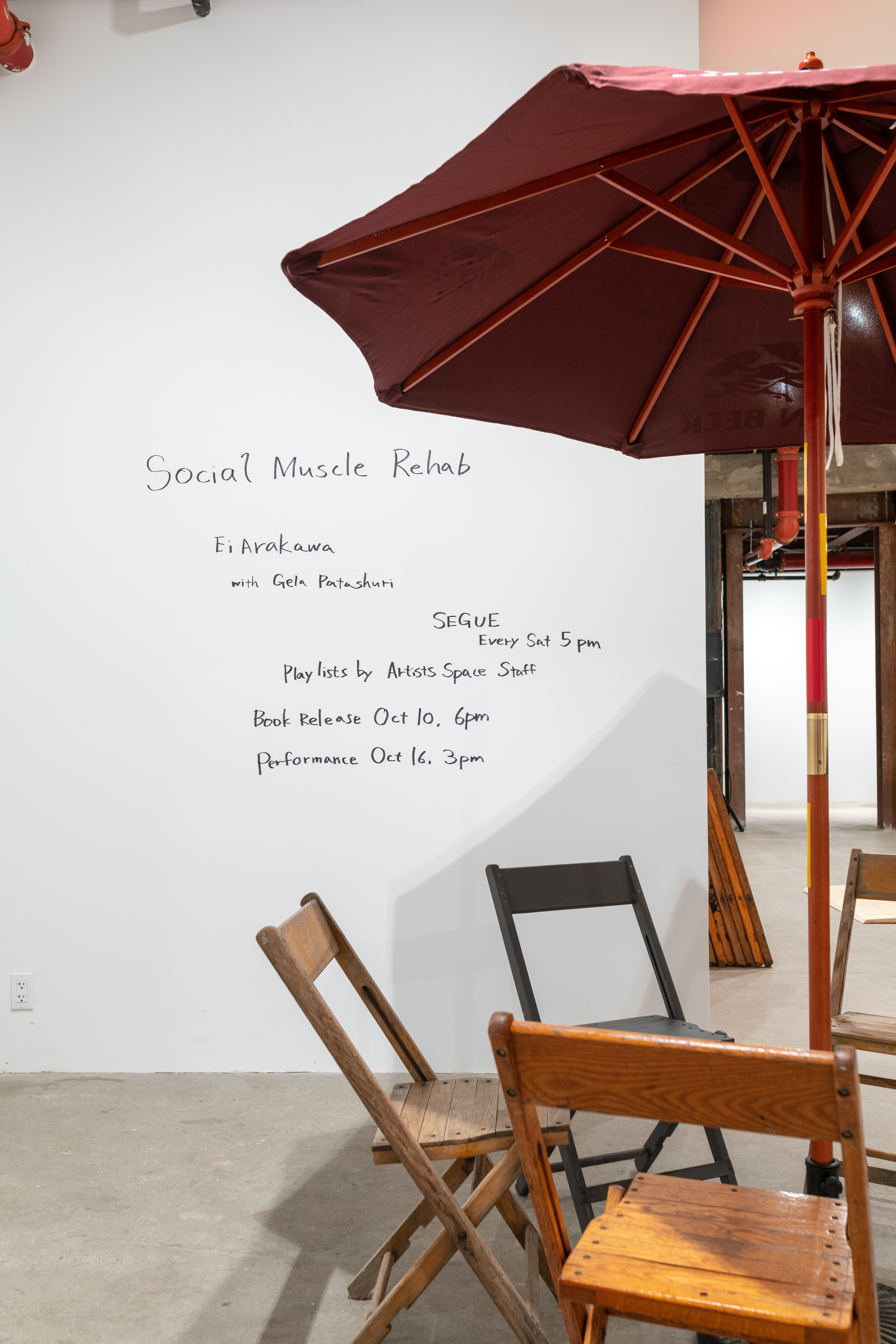 KR: Your title for this show, “Social Muscle Rehab,” feels so appropriate for this moment. So many of us are feeling, right now, that our social skills have atrophied and that we need to relearn the things we used to do. There’s also a sense that maybe we’re going to try to do things a little differently going forward.
KR: Your title for this show, “Social Muscle Rehab,” feels so appropriate for this moment. So many of us are feeling, right now, that our social skills have atrophied and that we need to relearn the things we used to do. There’s also a sense that maybe we’re going to try to do things a little differently going forward.
EA: It means so many different things. One literal meaning is that we all have weak social muscles from the Covid time. But it’s also, I think, a statement of where my practice as a performance artist is headed. I am not sure if it’s because of Covid, but I am having a mid-career moment in my practice. I’m thinking about what is a sustainable way of working, whether it’s interesting to work with galleries every year for the art fairs. I was questioning, even before Covid, how I can keep performing.
KR: How have you adjusted your practice?
EA: Before the pandemic I traveled almost six months out of the year. I was always somewhere, doing a performance or show. That stopped, and it was a very big difference. I had almost no performances last year. I did some Zoom talks and I started to envision a YouTube channel. It was strange not to do any performances last year, but at the same time it was also okay. Everybody else had this pause for a while, and I had to figure out what that meant as a performance artist.
When Artists Space director Jay Sanders asked me to do this show, we thought we might do a retrospective. I just published my first monograph, with Kunstverein für die Rheinlande und Westfalen, Düsseldorf and Artists Space, which covers the last eighteen years of my practice, and was in a retrospective mood. In the end, we made a group decision to do more of a present-time response. But it has some sort of connection to my past performances.
This show is sort of a transitional performance for me. The tennis player Naomi Osaka’s statements come to mind—she is refusing to participate in a lot of the pre-existing structures for her field. She’s also trying to influence the structures in which she is participating. I was very interested in her comments about refusing certain things which people are expecting from her, like press interviews. She’s a tennis champion and she cares about her mental health. I’m no champion of art, but I think there’s a performance anxiety I can relate to very well.
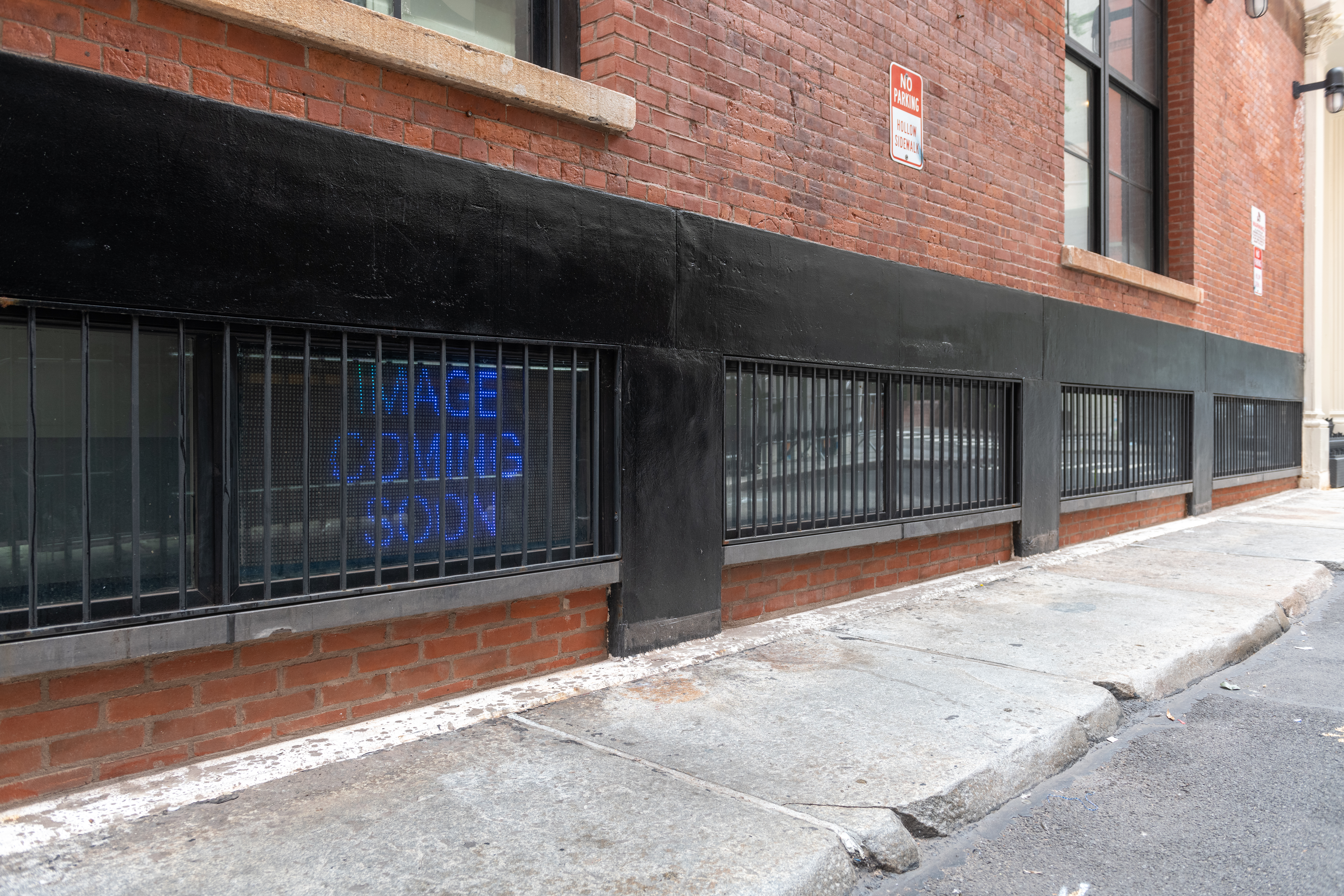 KR: Osaka is such a fascinating figure. Are there other aspects of her life and career that you are thinking about? Like you, she has spent time in Japan and America. She is also very involved with social justice issues.
KR: Osaka is such a fascinating figure. Are there other aspects of her life and career that you are thinking about? Like you, she has spent time in Japan and America. She is also very involved with social justice issues.
EA: Although this isn’t the main connection in the show, I am thinking about having a family with my partner and I was curious about the duality that she has. I became an American citizen in 2019, right before Covid started. Coincidentally, that was the time Osaka became a Japanese citizen. So I was curious what it meant to be not Japanese while my identity was coming from Japan. She is Japanese, but she has so many different backgrounds. She’s also a Black woman. I was curious to understand Japanese identity as a more precarious thing, I think.
KR: Speaking of Japan, in this show you have also incorporated ocean water from your hometown of Fukushima into a kind of fountain that’s running through the gallery, with gutters running along the length of the dining shed. What is the significance of the water here?
EA: It depends on how much people are aware of the circumstances around it—that the Japanese government will be releasing contaminated water from the Fukushima nuclear disaster into the ocean next year. So it’s a very fragile water, meeting with a precarious monument from New York City.
Some people might see it as more of a Zen garden thing—we were very careful to install it so that it sounds soothing. Or people might see it as a poetic gesture of homesickness, because this is the ocean water sent by my mother at a moment when I have not been able to go back to the country for two years.
People have also mentioned the floodwaters from Hurricane Ida, the water in the basements. And to me this water is like a fountain—I wanted to have some kind of public space in the basement, a shelter around the water. Having a street structure in the basement is also, somehow, playing with people’s expectations.
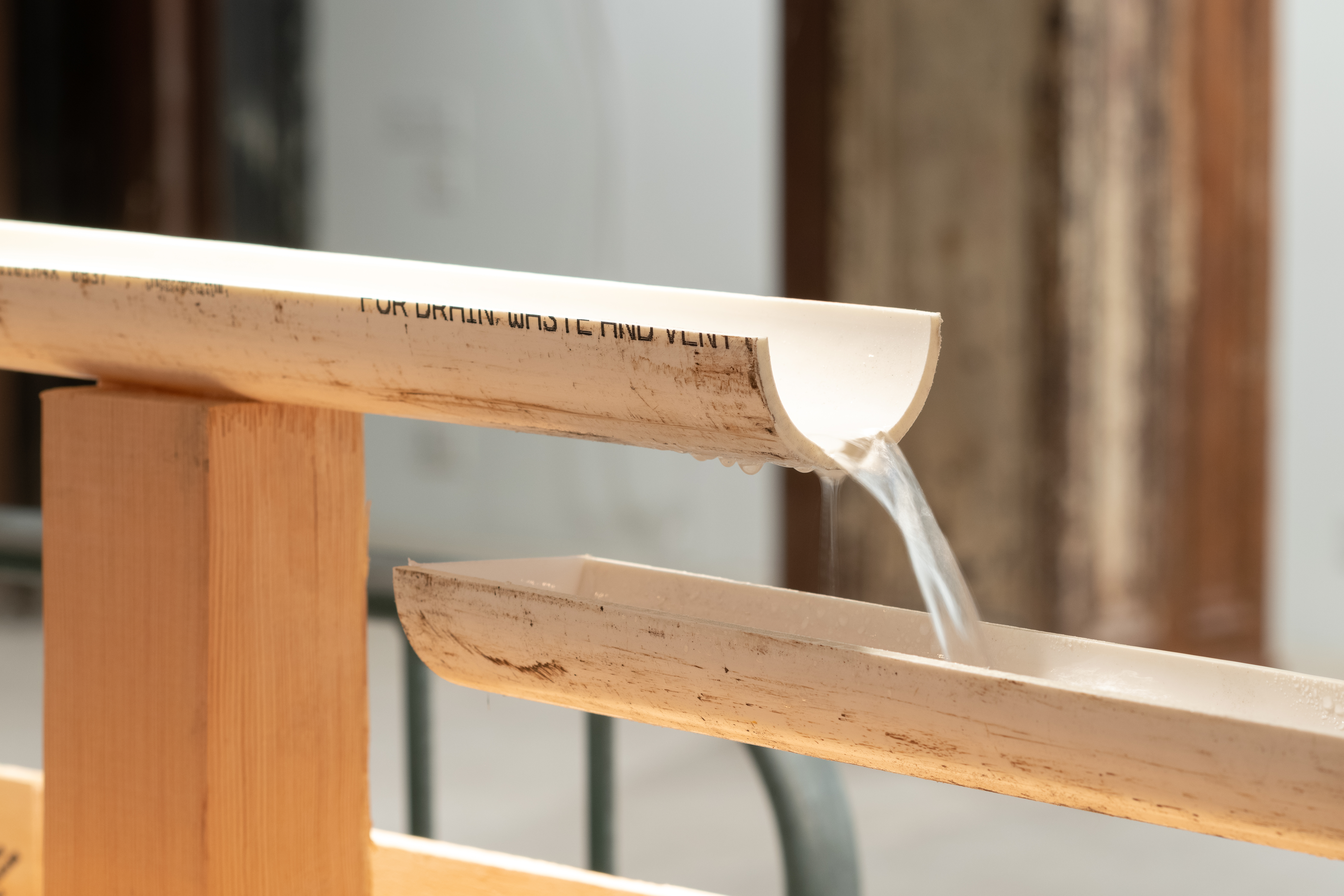 KR: Your art often references historic Japanese art movements, such as the Gutai group or Jikken Kobo. What is it about them that has inspired you?
KR: Your art often references historic Japanese art movements, such as the Gutai group or Jikken Kobo. What is it about them that has inspired you?
EA: I was a student around the time of Okuwui Enwezor’s Documenta 11, in 2002, and I was very encouraged by the post-colonial ideas. I was studying in New York and hanging out with people from the Reena Spaulings gallery, especially people who were connected with a German art context. I had the idea that I also needed to offer something from my own background, so I started to study Japanese modern art histories.
In Japan, there’s a very long history of collective performance since the 1920’s. Jikken Kobo and Gutai are two collective art movements that I was associated with, but more generally I relate to this swell or wave of collective performance that Japanese art has produced.
Gutai, for instance, did a lot of outdoor performances in public spaces. That kind of thinking outside a pre-existing art system was very important in Japan, where there was not really an established set of galleries or institutions like in the U.S. or Europe. In addition to Jikken Kobo and Gutai, there’s another group called Hi-Red Center that did a lot of influential work in the ‘60s. It’s almost a Japanese version of Fluxus.
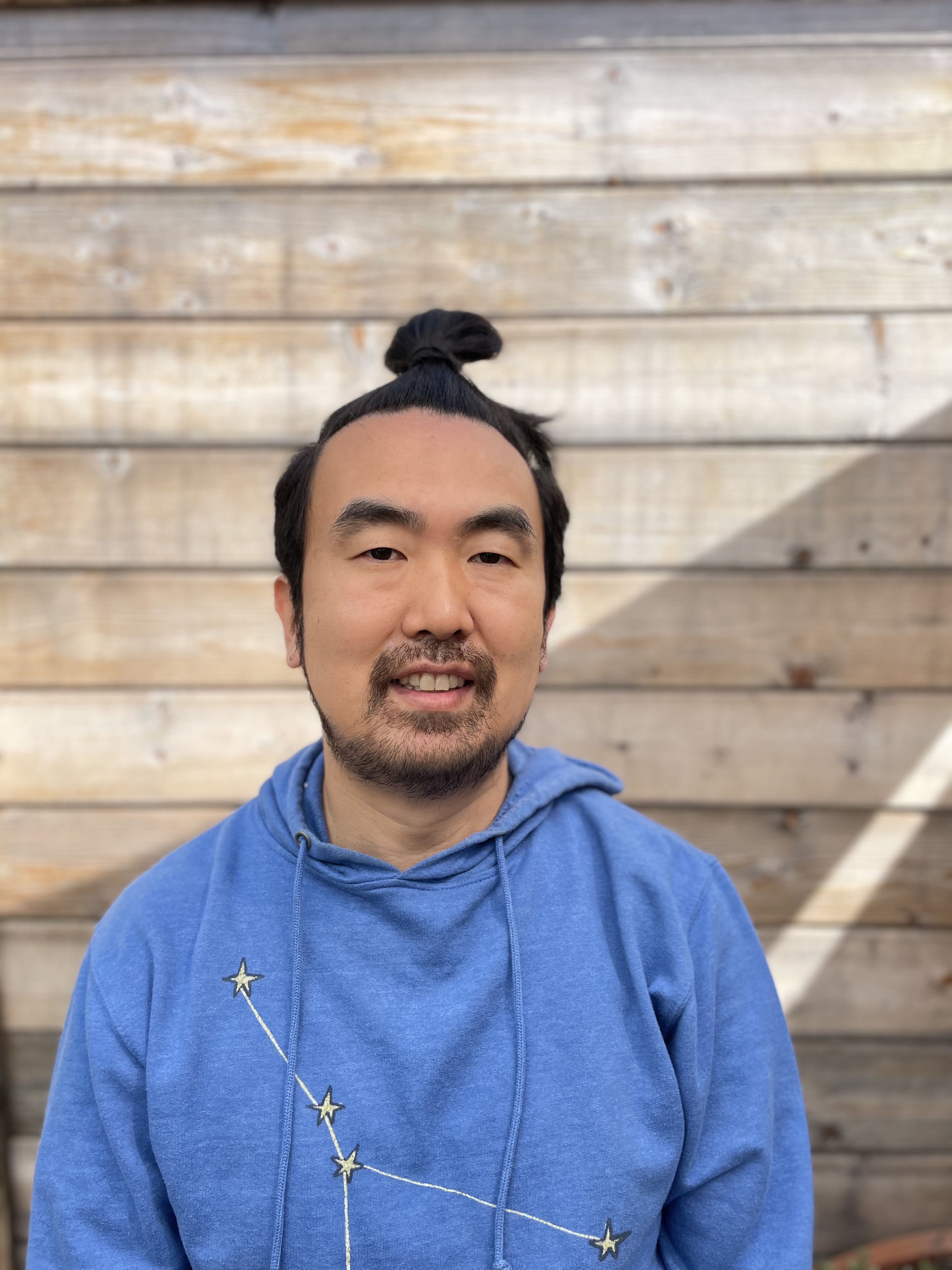 KR: Your art, like the work of these groups, is very collaborative. For this show, you teamed up with the Georgian artist Gela Patashuri. What role did he play in the exhibition?
KR: Your art, like the work of these groups, is very collaborative. For this show, you teamed up with the Georgian artist Gela Patashuri. What role did he play in the exhibition?
EA: Gela and I have been working together for more than ten years. He’s a carpenter, so when we work together it’s always something architectural. One time we were involved with a project called Kamikaze Loggia for the Georgian Pavilion of the Venice Biennale. The idea came from this phenomenon of precarious balcony extensions in post-Soviet Georgia—in the late 1990s, a lot of families in Tbilisi extended their houses with illegal balconies. Often they were not safe, and they fell like a kamikaze.
Gela built the dining shed in a very short time—it’s not like we hired some 100-person art production team to make this structure. It has a much more handmade presence. That was important, to have this sense of improvisation.
KR: What can we expect to see in the performance you are doing outside the gallery on October 16?
EA: The location is important, because Cortlandt Alley is a very iconic street. It’s not an art space, and many different people pass by—homeless people use it as a toilet sometimes. It’s a real sort of street. I always like to do a performance in a non-art situation. I’m gathering some tennis players, maybe six or eight people—hopefully people of color. We are going to do a sort of a tennis exercise—we want to set up a net in Cortlandt Alley and do a tennis rally. Almost like a golf driving range, but for tennis. I wanted this kind of extreme release of hitting a ball into the air, to the sky, as a form of rehabilitation. There will also be an LED display set up on the window, quoting some of Osaka’s tweets and messages. And because October 16 is her birthday, I may set out some cake.


